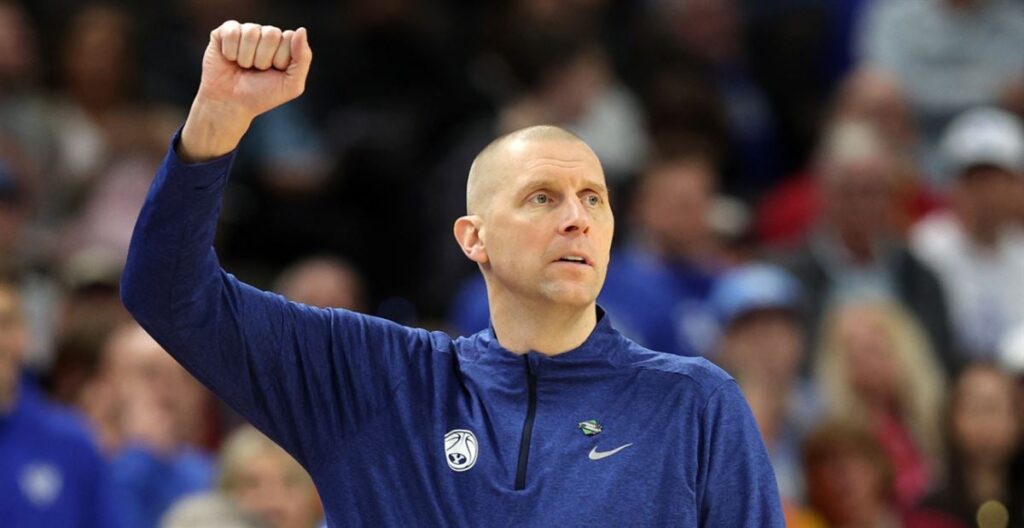It wasn’t Dan Hurley, Nate Oats or Scott Drew. Reportedly, Billy Donovan and Rick Pitino were never seriously pursued. Instead, Mark Pope is succeeding John Calipari as the next head coach at Kentucky.
Pope has spent the last five years as the head coach at BYU before coming to Kentucky, leading the Cougars to two NCAA tournaments (including a birth this season after finished with a 23-11 overall record in their first year in the Big 12).
RELATED: Kentucky hiring Mark Pope: Everything you need to know about the Wildcats new coach
Pope — who was reportedly the personal choice of athletic director Mitch Barnhart — played two years at Kentucky and won a national championship under Rick Pitino before graduating in 1996. And, let’s face it, in many ways he is the anti-John Calipari.
There’s no denying Pope doesn’t have the same personal brand that Calipari possesses or some of the more prominent candidates Kentucky was believed to be targeting during their search. As a result, the first questions about Pope’s qualifications are likely going to center around his ability to keep Kentucky recruiting in tact.
This is a fair question. But, the reality is that Calipari’s relationship with Barnhart and Kentucky as a whole didn’t sour because his recruiting prowess had slipped. More than anything, things went south because of the Wildcats’ lack of recent postseason success.
Those March struggles can be attributed to a variety of different variables. Calipari, himself, critiqued his commitment to the “One-and-Done” model following Kentucky’s first-round loss to Oakland last month. But a more common critique has been Calipari’s style of play and the way it hasn’t evolved.
Mark Pope may be the anti-John Calipari when it comes to the Xs and Os, as well.
Calipari was often criticized for his antiquated offensive philosophies. 3-point shooting was rarely prioritized, two bigs were frequently used together, and as a result, the team’s spacing suffered. Even this year, when Reed Sheppard and Robert Dillingham unexpectedly seized control of the backcourt and gave the Wildcats the best 3-point shooting team in the country, they still only ranked 179th in the country (that’s in the bottom half) in the number of 3s they attempted as a team.
As for Mark Pope, his BYU teams took more than half of their shots from behind the 3-point line. This is the fourth-most of any program in the country in this stat, despite the fact that they made under 35% of them. All five players on the floor were frequently shooting threats from 3 which made their spacing impeccable. This allowed Pope to utilize modern “five-out” concepts where everyone was positioned outside the arc.
Mark Pope’s offense at BYU:
▪️took more 3s than 2s & played with great spacing
▪️were 6th in the country in assists to FGs made per @kenpomeroy (while also having a low turnover rate).
VIP: https://t.co/mPmvBuW64t pic.twitter.com/HCd1DczEe6
— Adam Finkelstein (@AdamFinkelstein) April 12, 2024
While Kentucky played with very good pace this year, that was not representative of what we’ve seen over the years. Prior to this season, the last time they finished in the top-140 of overall tempo in Division I basketball was back in 2016-17. Last year, they were the 256th team in the country in that stat. Their slow tempo was also counterintuitive for a team that recruits so well. Theoretically, more possessions should give the team with superior talent more opportunities to separate themselves.
Pope’s teams have ranked in the top third in pace in four of his five years at BYU and they were getting progressively faster with each passing year. The trendy “pace and space” concepts that originated in the NBA back when Lebron James played for the Heat seemed applicable to what happened in BYU’s offense. But, they don’t just shoot a lot of 3s and look to run. They look to run for 3s. Often, BYU would be seen throwing the ball ahead in transition and often letting it fly before it ever gets inside the arc. In fact, the Cougars averaged more attempted 3s in transition than they did in the half court.
Pope’s teams have played with good pace, ranking within the top third of cbb in 4 of his 5 years at BYU and getting progressively faster with each year.
They also run for 3s, taking more threes in transition than they did in the half court.
VIP: https://t.co/mPmvBuW64t pic.twitter.com/mCvsFDe0er
— Adam Finkelstein (@AdamFinkelstein) April 12, 2024
Another major distinction between Calipari and Pope’s offensive system is the flow between their transition and half court offense. At Kentucky, those were often two very different segments over the years. If they ran and didn’t score, they would pull the ball out and set something up. At BYU, Pope’s transition game flows directly into his half court offense, utilizing that five-out spacing so that the trail big man runs to the top of the key and is frequently used as a passer. This opens the lane up for cutters, different types of offensive actions and creates driving lanes.
Their transition attack also flows right into their 5-out spacing, opening the lane for cuts, drives, & various offensive actions…which explains why they shoot such a high percentage on 2s regardless of their high volume of 3s.
VIP: https://t.co/mPmvBuW64t pic.twitter.com/AnNN8GmWxu
— Adam Finkelstein (@AdamFinkelstein) April 12, 2024
Even though BYU shoots a lot of 3s, they are incredibly efficient shooting 2s (No. 8 overall in the country this year). This is because their spacing often pulls all five of the opposing defenders away from the paint. They are also an exceptional passing team (No. 6 overall in the country). They don’t just make plays within their actions, but also make extra passes around the perimeter once they get the defense scrambling.
So, will Mark Pope recruit like John Calipari? Maybe not. But that might not be his objective, either. While his system at Kentucky may not be a total replica of what he did at BYU since he’ll have better access to talent, it’ll likely have similarities to it since it will likely prioritizes skill, shooting and feel. If this offensive system creates a more modern attack that are better suited to win in March, then fans may be willing to sacrifice the top-ranked, pro-ready recruiting classes that highlighted Calipari’s tenure.

